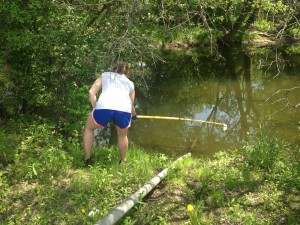My former dean was known as Dr. Clorox while serving in Vietnam.
 I used to give these training sessions to food types headed for Iraq and Afghanistan from Fort Riley (in Manhattan, Kansas) and would sheepishly say, I have no idea what you’re going to face in terms of potable water, but bleach is your friend.
I used to give these training sessions to food types headed for Iraq and Afghanistan from Fort Riley (in Manhattan, Kansas) and would sheepishly say, I have no idea what you’re going to face in terms of potable water, but bleach is your friend.
We take so much for granted.
In the developing countries, inaccessibility to safe water, lack of agricultural infrastructures and limitations to implementing good agricultural practices (GAP) are persistent challenges.
To understand the spread of hazards and identify critical areas of transmission in the food chain, a total of 90 samples of raw salad vegetables (parsley, lettuce, radish) were collected from farms and post-harvest washing facilities (n = 12) in an extensively cultivated area in Lebanon, the Bekaa Valley and from wholesale market stalls traced back to surveyed fields.
Our results showed high geometric mean indicator levels ranging from <0.7 to 7 log CFU/g (Escherichia coli), 1.69–8.16 log CFU/g (total coliforms), <0.7–8.39 log CFU/g (Staphylococcus aureus). The mean counts of total coliforms and E. coli on fresh produce followed an increasing trend from fields to the markets indicating potential sources of fecal contamination throughout the food chain. Of more concern was the presence of pathogens Listeria monocytogenes (14%) and S. aureus (45.5%) in fresh produce from harvest to retail, and Salmonella spp. was detected in 6.7% of the raw vegetables from the post-harvest washing areas.
 These results along with our observations highlight shortfalls in hygienic farming and postharvest practices, including the use of inappropriately treated manure and chicken litter to fertilize the crops on the fields which contributed to the high levels of S. aureus in the product at retail. Unregulated use of wash water, inadequate transportation and storage conditions with risks of cross contamination was also identified.
These results along with our observations highlight shortfalls in hygienic farming and postharvest practices, including the use of inappropriately treated manure and chicken litter to fertilize the crops on the fields which contributed to the high levels of S. aureus in the product at retail. Unregulated use of wash water, inadequate transportation and storage conditions with risks of cross contamination was also identified.
Suggested control measures should mitigate the risks at the source and put emphasis on developing strict policies on monitoring the safety of water sources and on the application of the good agricultural and hygienic practices (GAP, GHP) on primary production stages, washing, transportation and storage at retail.
Understanding the routes of contamination of ready-to-eat vegetables in the Middle East
Food Control, Volume 62, April 2016, Pages 125–133
Dima Faour-Klingbeil, Muhammad Murtada, Victor Kuri, Ewen C.D. Todd
http://www.sciencedirect.com/science/article/pii/S0956713515302462







.jpg) from cantaloupe consumption since 1984.
from cantaloupe consumption since 1984. .jpg) Colorado were implicated.
Colorado were implicated.